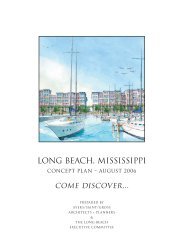Reports - Mississippi Renewal
Reports - Mississippi Renewal
Reports - Mississippi Renewal
- No tags were found...
Create successful ePaper yourself
Turn your PDF publications into a flip-book with our unique Google optimized e-Paper software.
THE GOVERNOR’S COMMISSION REPORT | 103its, similar to successful programs usedin <strong>Mississippi</strong> and Texas, as an incentivefor private investment for the reforestationand wildlife restoration in countiesdesignated as Presidential Disaster Areas.The program would be administeredthrough the U.S. Department of Agriculture,Forest Service’s State and PrivateForestry Division and implemented bythe state Forestry Commission and stateFish and Wildlife Foundation. Underan agreement with the landowner, theappropriate state agency would providevoluntary technical and financial assistancefor up to five years to help restoreforests and fish and wildlife habitat onthe property through the proposed taxcredit based program. Any individual,group or association would be eligibleto participate in the program.To be eligible for the tax credit, alandowner must have a restorationplan prepared for the eligible tract bya registered forester or certified fish orwildlife biologist. The forester or biologistwould certify, in writing, that theconservation practices were completedand the conservation plan followed. TheU.S. Forest Service, in consultation withthe state forestry and fish and wildlifeagencies, would determine the eligibleactivities, which could include: forestrestoration and debris removal, controlor eradication of invasive species, sitepreparation, tree planting, direct seeding,firebreaks, restoration of hydrology,restoration of wildlife habitat and corridors,fencing for habitat protection,removal of barriers for aquatic species,stream bank stabilization, restorationof threatened and endangered specieshabitat and corridors, and restoration ofrivers and streams.The Commission recommends thatany eligible owner who incurred costsfor approved restoration practices oneligible lands be allowed a tax credit, inan amount equal to the lesser of 75 percentof the actual costs of the approvedconservation practices or 75 percent ofthe average cost of approved practicesagainst the taxes imposed for the taxyear in which the costs are incurred.A landowner would be eligible for upto $50,000 of tax credits per year for amaximum of three years after the presidentialdeclaration with any unusedportion of the credit being eligible tobe carried forward in succeeding taxyears. The Commission also recommendsa similar restoration tax creditfor homeowners limited to $1,500 peryear for three years to help restore urbanand community forests.Invasive Species ControlHurricane Katrina spread invasivespecies of plants into the damaged forestsof South <strong>Mississippi</strong>. In areas withsevere wind damage, the removal ofthe forest canopy would dramaticallyincrease available sunlight reaching theunderstory and encourage an explosionof many highly invasive species. Withoutaggressive action, it is extremelylikely that these species will “capturesuccession” across thousands of acresand prevent reestablishment of nativeforests across ownerships, including anarray of ecologically and economicallysignificant public and private lands. Itis highly likely that the movement ofheavy equipment through infested areaswill exacerbate the spread of cogongrass,an invasive grass spread by windblownseeds and underground creepingrhizomes.The Commission recommends a $30million congressional appropriation tofund the Environmental Quality IncentivesProgram (EQIP) or to provide adirect EQIP appropriation to the Mis-Hurricane Katrinaspread invasivespecies of plantsinto the damagedforests of south<strong>Mississippi</strong>.




